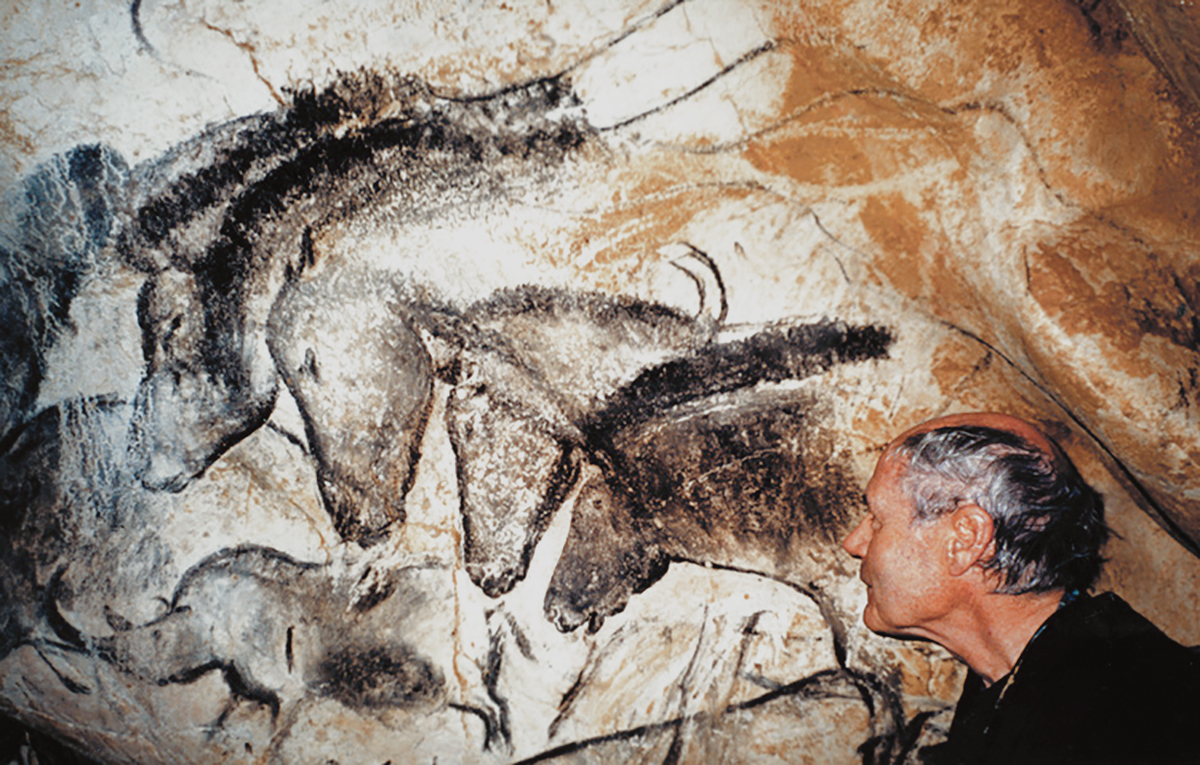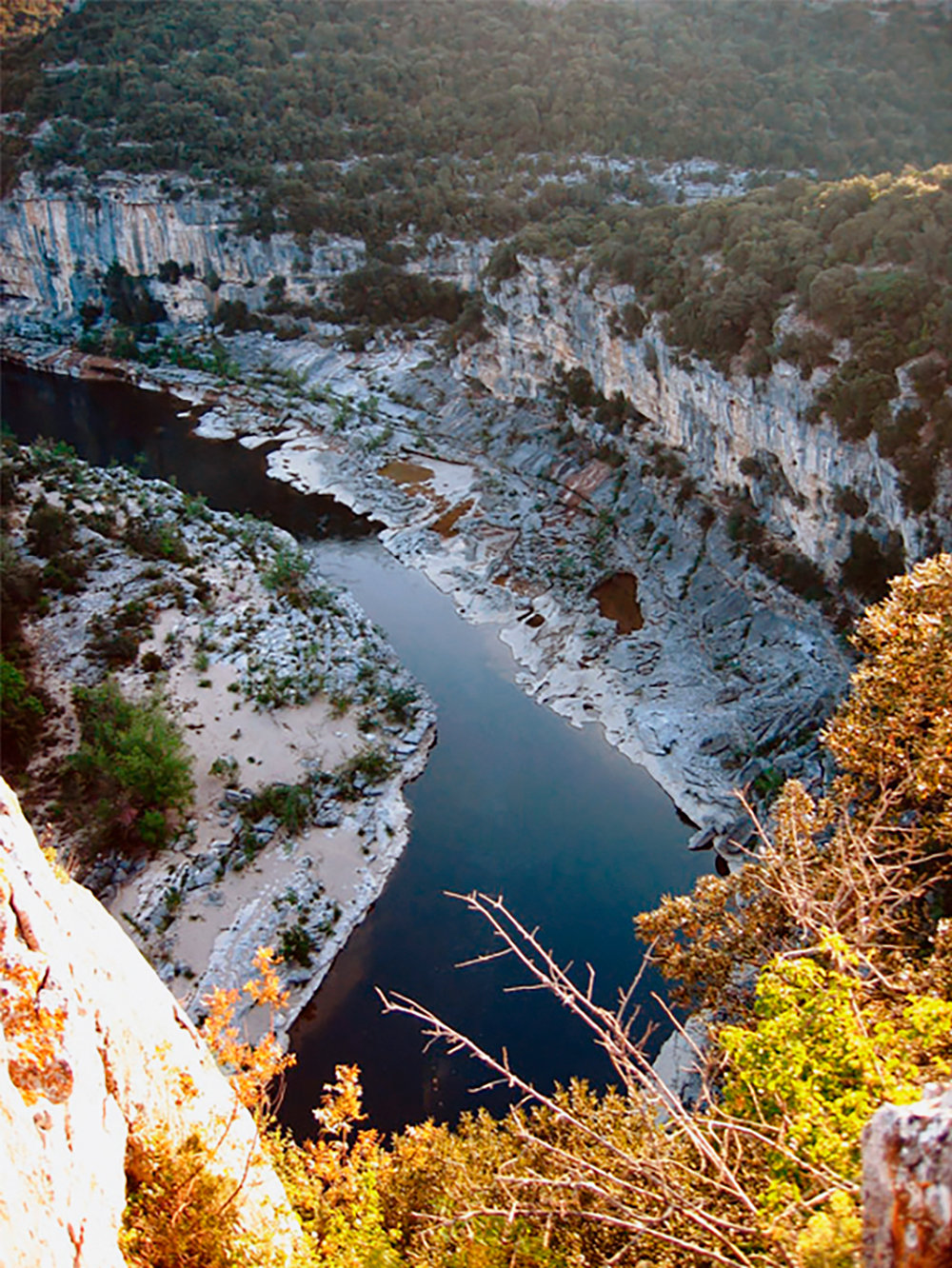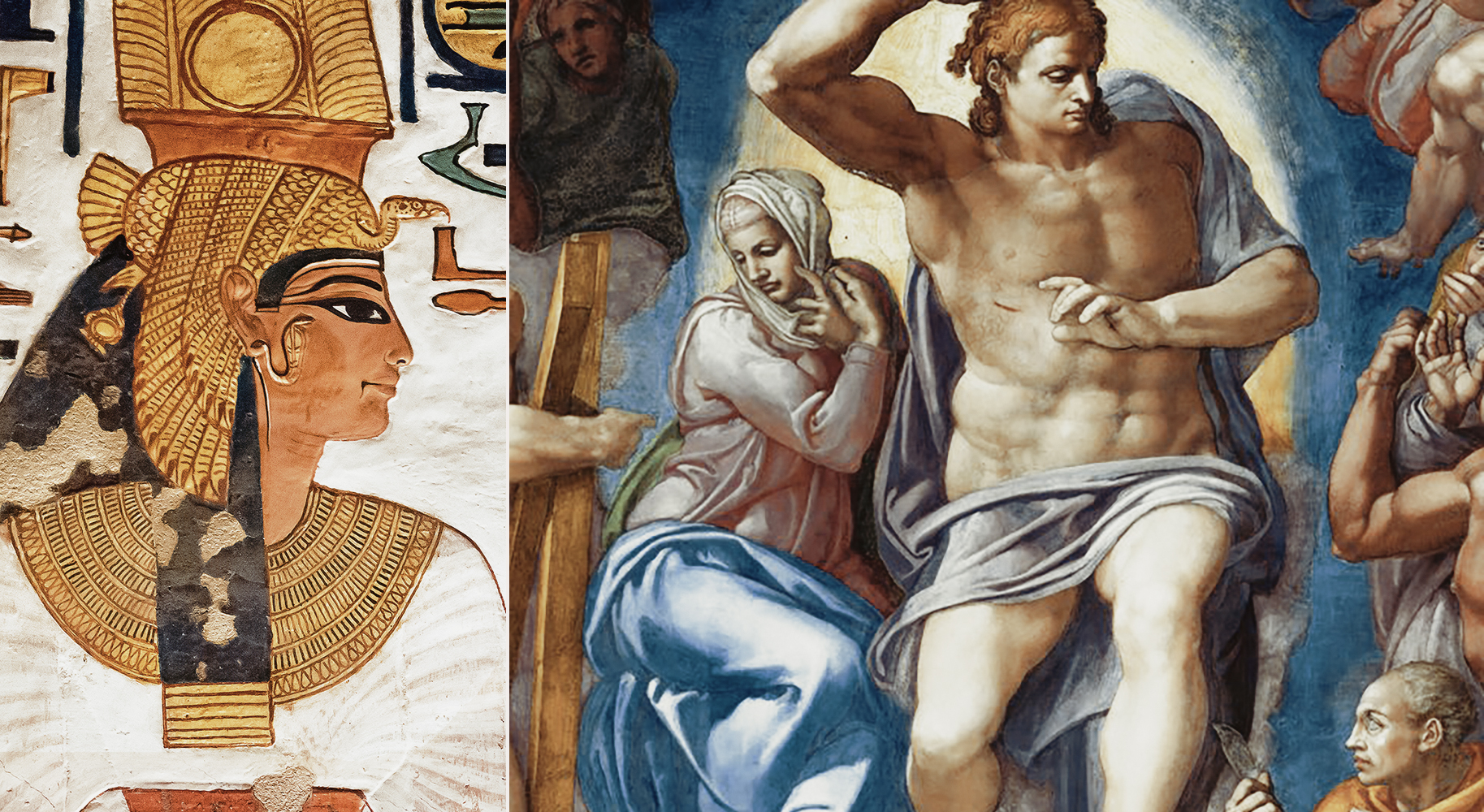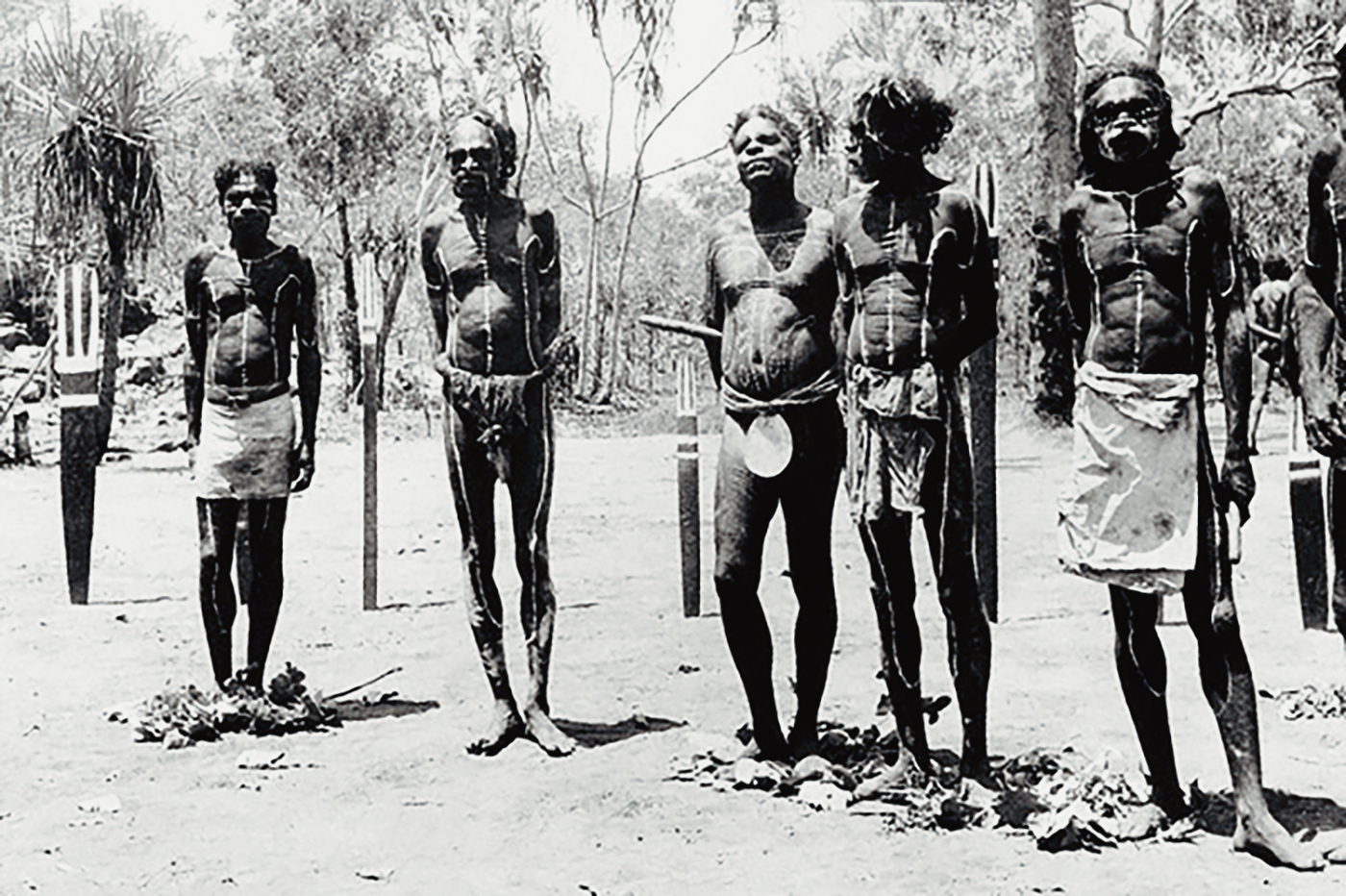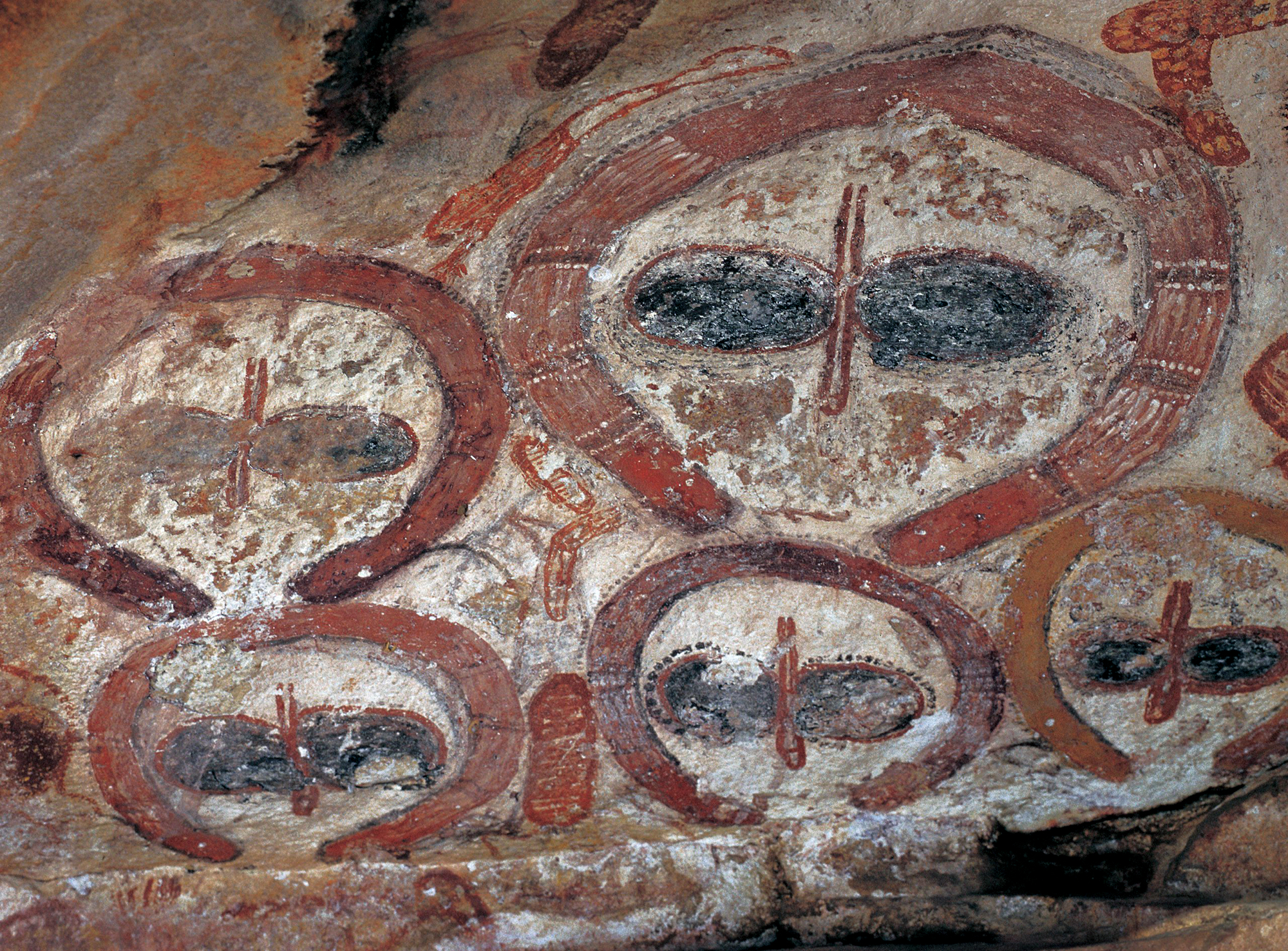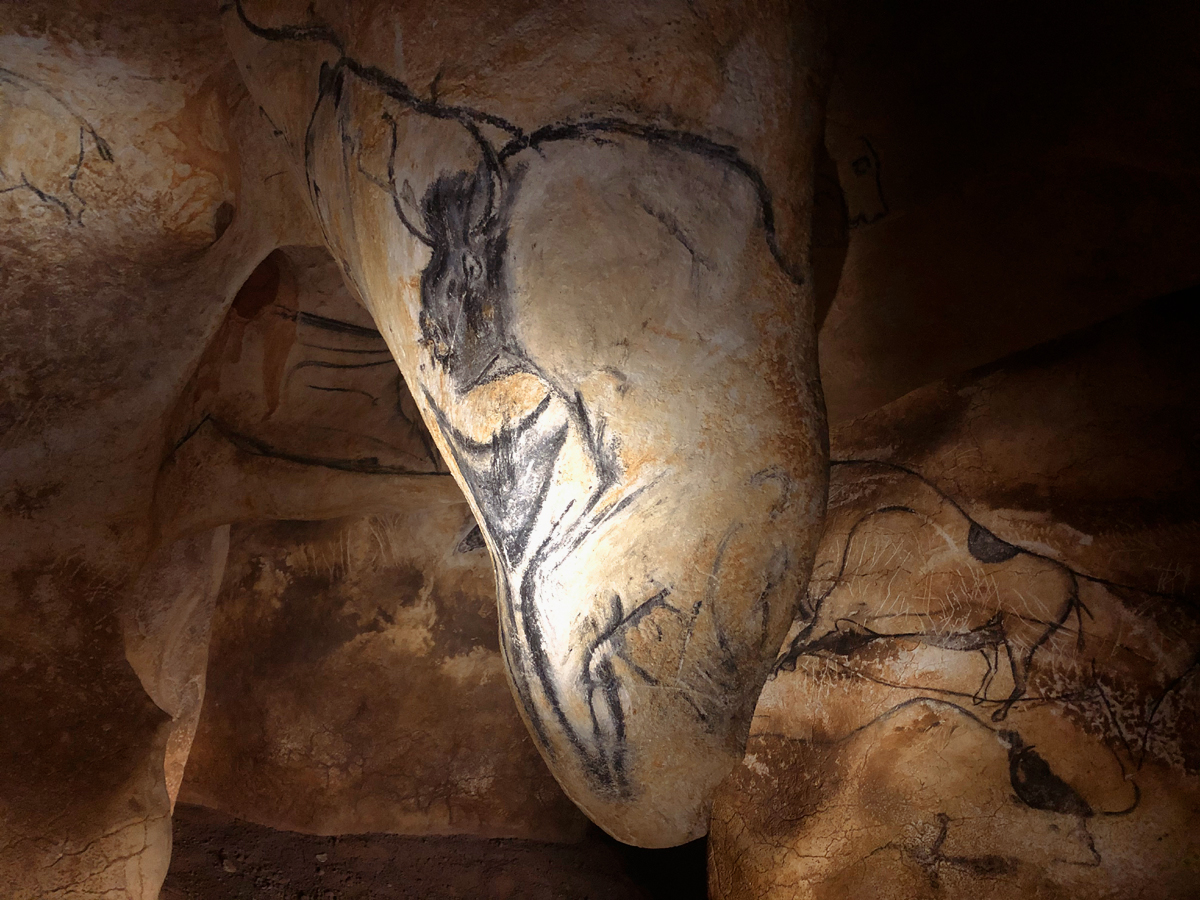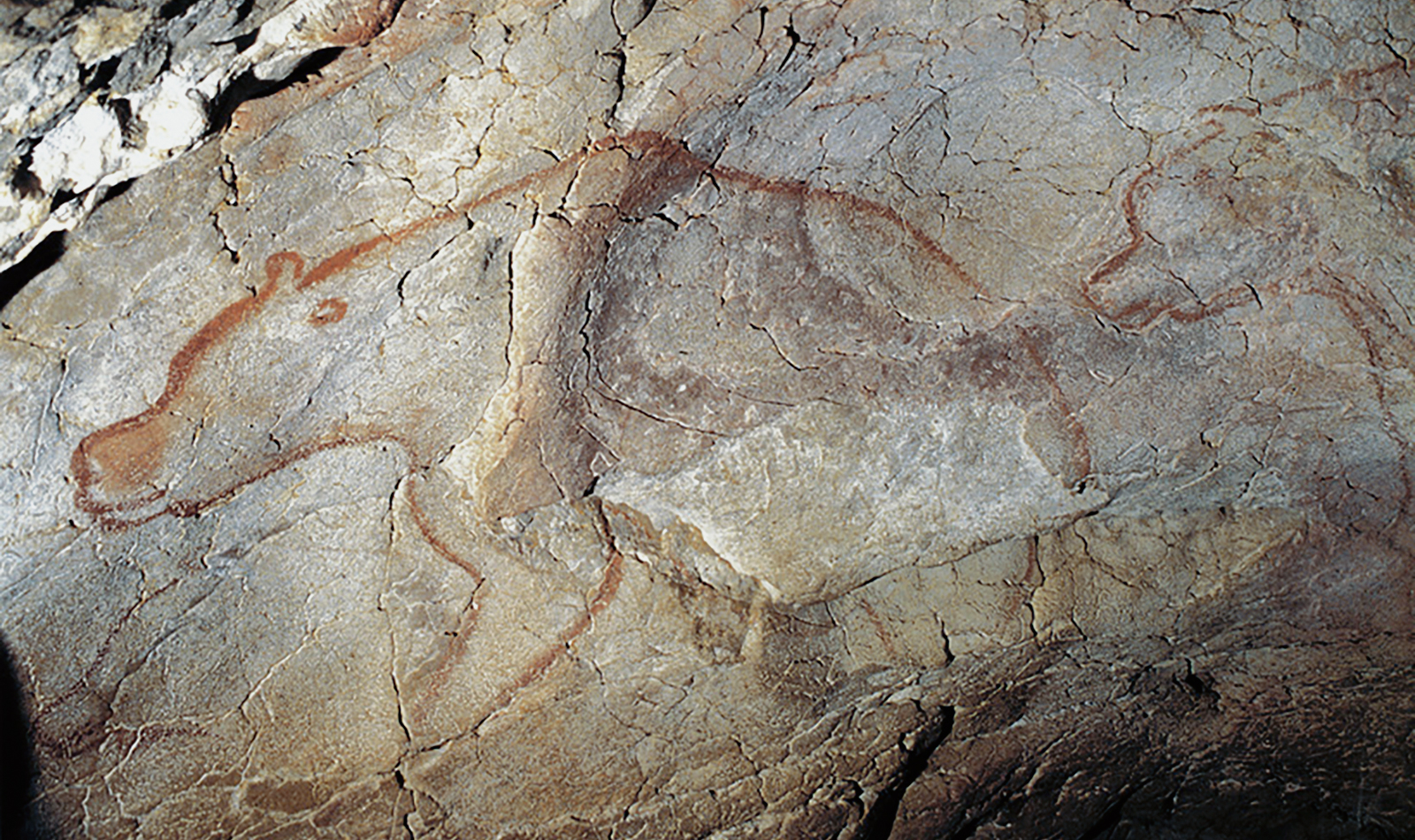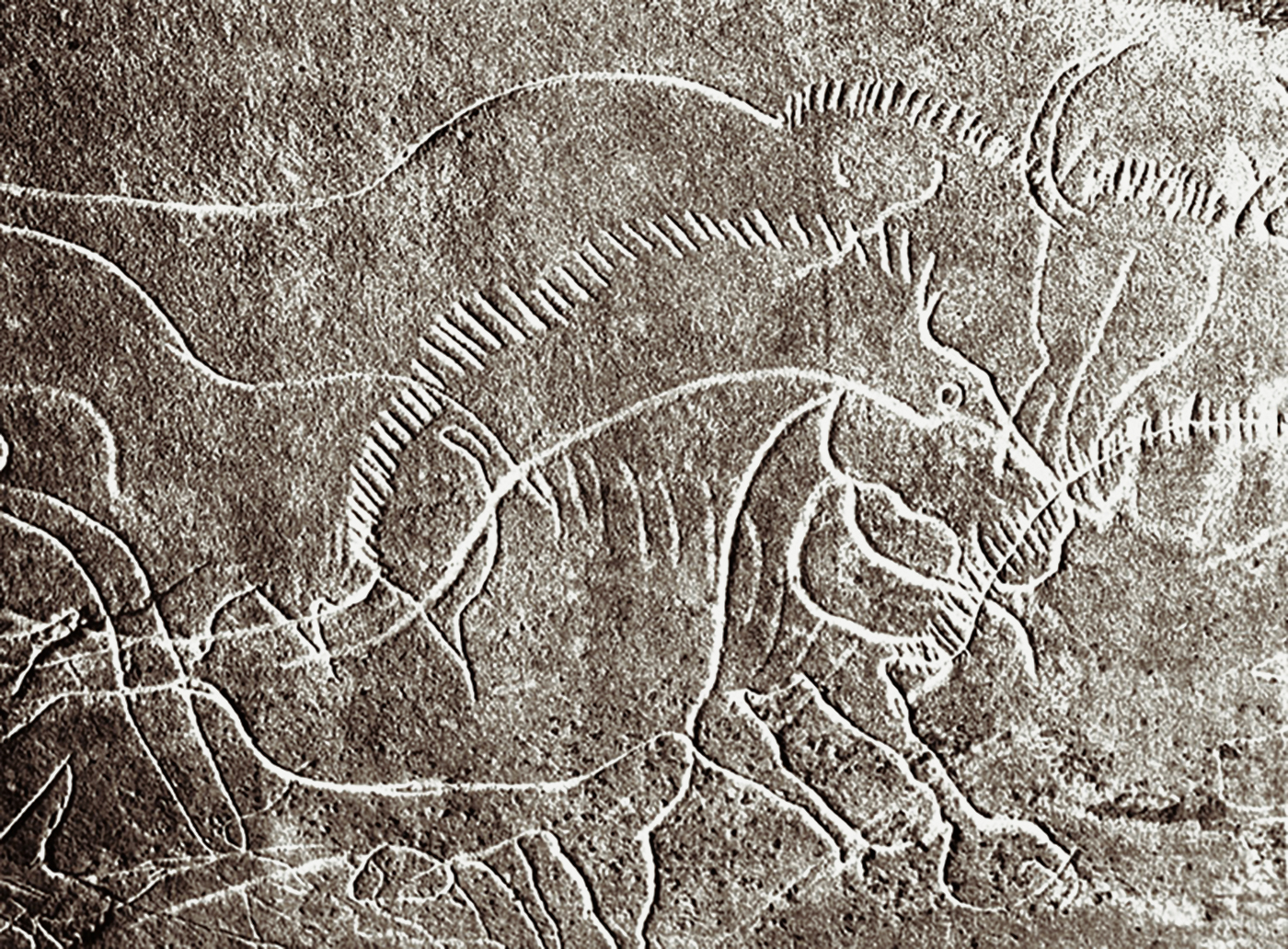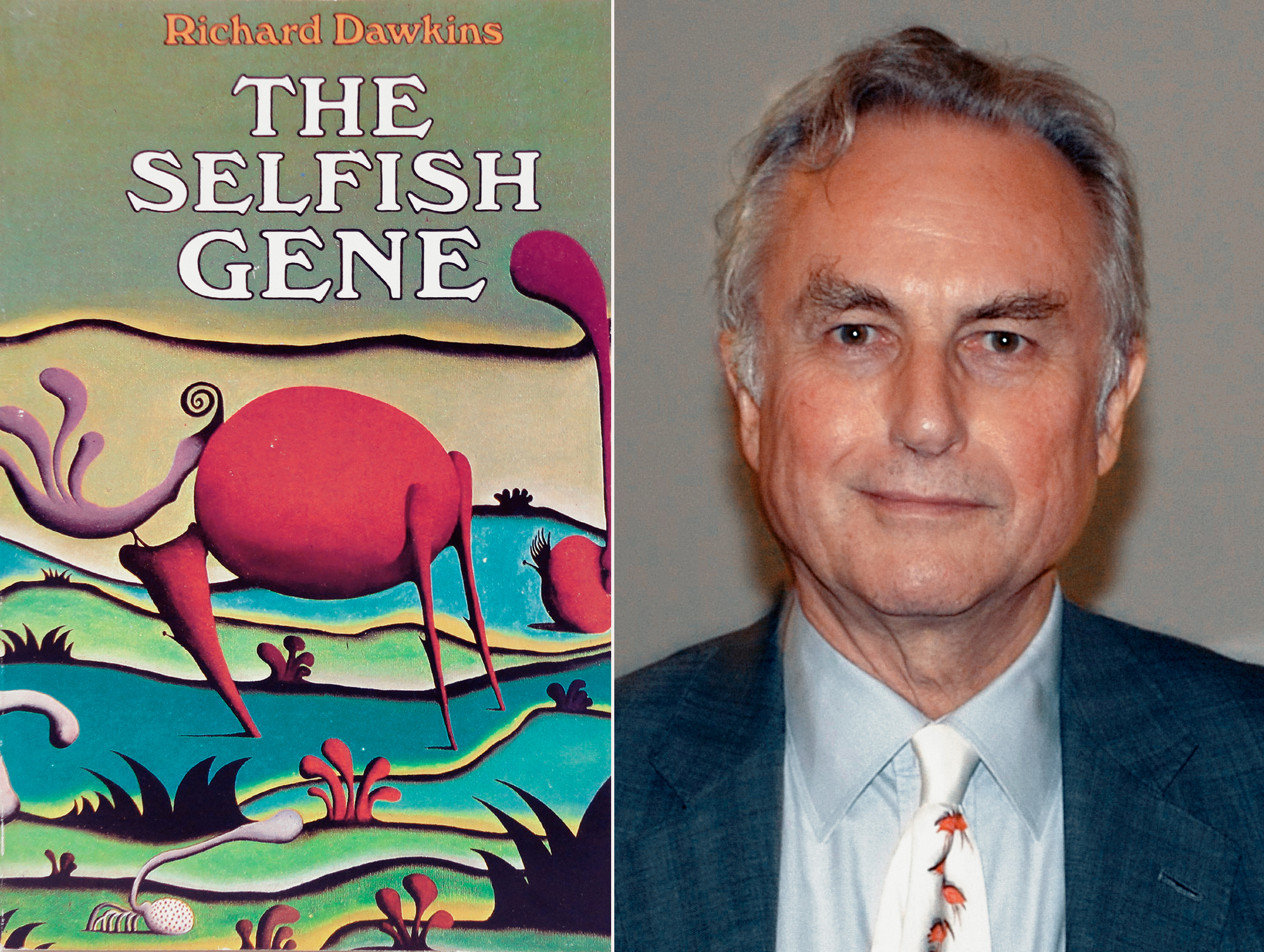
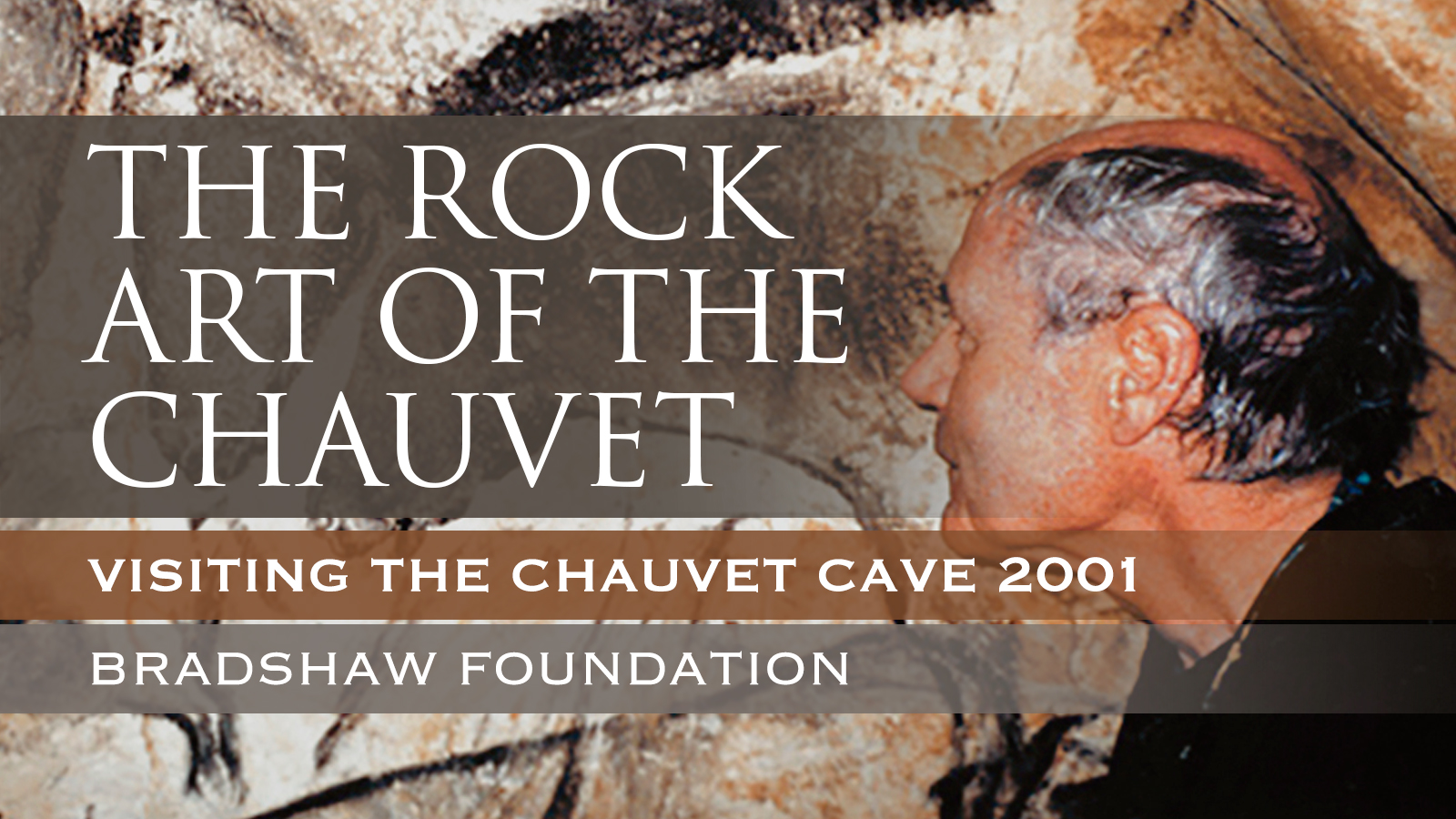
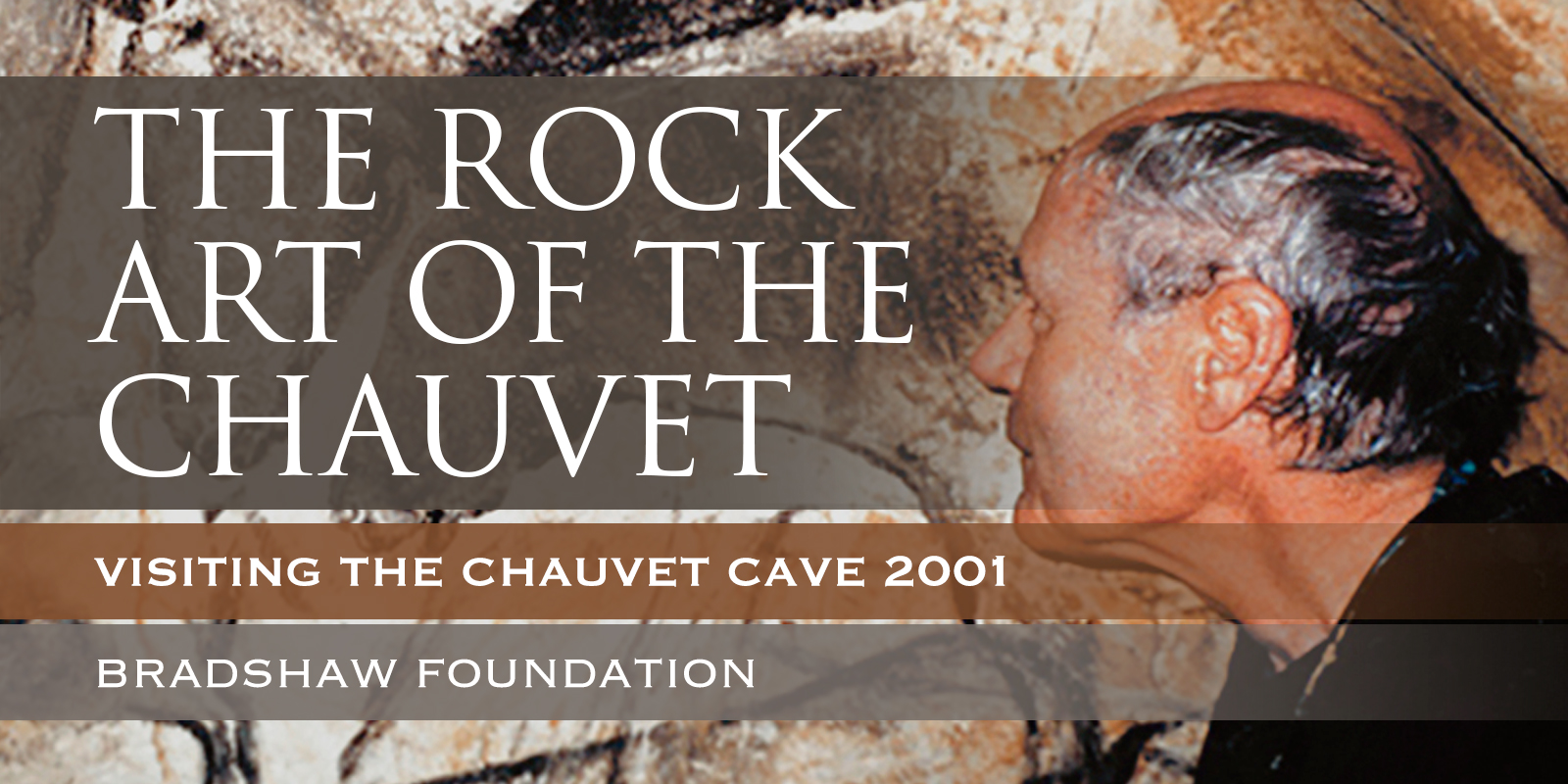
Two years had passed since my first visit to the Cave. I had come away from the magic world of Chauvet with impressions that had left me in a state of wonderment. In the interval between then and now not a day had passed without my thinking about what I had seen and felt. The images had constantly been in my mind’s eye since then, and left me with hundreds of questions. On this visit I hoped that I would be able to peer through at least some of the veils that shroud the secrets locked inside Chauvet.
The first visit had been one of the greatest experiences of my life and had made an enormous impact on my way of thinking about Art. However over the last two years I have found that it has made an even greater impact on how I thought about Cro Magnon, so I would make this visit with a completely different mental approach. My keenness to once again be in the cave was now linked more to thinking about the Artists than about the Art. I knew the adrenaline would once again race through my veins, but what would my reaction be this time?
For me the two most wonderful things in the Universe are firstly, the Evolution of Mankind, and secondly, our Artistic Creativity. The fact that Humankind can balance on two feet and walk upright, is a miracle. The miracle is possible because a super computer inside our skulls interprets the millions of messages that travel every second between our feet and our brains. This super computer is our Mind, the seat of our Artistic Creativity, the power that enables Humankind to transcend Darwin's conviction that "no innate tendency to progressive development exists".
I recently read something I think illustrates this perfectly. Marcus Aurelius wrote, “You consist of three things only, your body, your life, your mind; only the last is subject wholly to your control. All else is mere smoke”. Art is the pinnacle of Human Civilisation. I believe that the discovery of the Art in the Chauvet Cave is as important as Mankind travelling into Space and walking on the Moon. Art is the pinnacle of Human Civilisation. The Florentine Sperone Speroni, 16th century Renaissance writer, defined the key to Civilisation as “the Creation of Wealth and the Patronage of the Arts”. Art is the culmination of Mankind’s achievements and the oldest evidence of its existence is in the Chauvet Cave.
Jean had suggested that we meet at his Research headquarters so he could introduce me to George Chaloupka, the author of a book on the Dynamic figures of Arnhem Land, which are somewhat akin to the Bradshaw figures. He is the founding patron of Kakadu Park in Australia, and has done great things for the preservation and protection of Aborigine culture and art.
As soon as Jean was ready to leave we drove round to the vineyard where the track up to Chauvet starts. On the way we stopped to visit the river for a look at the Pont d’Arc in the morning light. What a spectacular site. The Arch spans the river in a lovely graceful sweep of white limestone. It is one of the most impressive natural phenomena that I have ever seen.
The water was crystal clear and the glassy surface of the river reflected the arch as it glided serenely through its vast open mouth. A flock of over fifty doves skimmed past us and flew under the arch. The Bear Clan must have found the Arch just as awesome 35,000 years ago as it is today. I agree with Jean, they must have seen it as a symbol of great magical potency.
Was the reason that the Chauvet Cave was the one chosen out of all the many caves in the Ardeche Canyon for these special paintings been because it is nearest to the Arch? The fact that the Arch looks like a Lion leaping across the river from the downstream side could only have added to the potency, the Spirit of the Place.
It was time to climb up the track to the cave. The first part of the climb is quite steep and in my hurry to get to the cave I soon ran out of breath. Jean took over the lead and set a proper pace.
We came out of the woods and stood looking out over the valley at the beginning of the terrace that cuts across the face of the cliff. The view out down the canyon was magnificent. This terrace was cut by the Ardeche river millions of years ago when it began to excavate the Canyon as it raced to join the Rhone and the Mediterranean.
The bears must have used this terrace to reach the cave for their winter hibernation, as this is the only easy way up to the Chauvet cave. When the Bear Clan artists had arrived in the Ardeche Canyon some 35,000 years ago, they must have followed the bears to their lair up this path as well.
Standing on the edge of the terrace I thought about the forming of the landscape and the fact that the Mediterranean Sea was dry five and half million years ago. It amazes me to think that at that time, while the rivers of Spain and France were flowing into a shallow lake between Spain and Sardinia, in Africa our ancestors were just beginning to walk on two feet!
The Bear Clan would have stood where I was now standing and gazed out at the same beautiful scenery. They would have perhaps watched the herds making their way along the valley as they migrated between their summer and winter habitats. Below me would have passed woolly rhinoceros, mammoths, bears and horses as they foraged. Lions could have stalked their prey watched by hyenas waiting to scavenge the remains of their kill.
While sitting in the dark of the cave two years ago, watching Jean working with a colleague on the Horse panel, I had experienced a kind of daydream. Seeing the two men studying the painting with their flashlights had summed up an image in my brain of cave men doing the same thing but with burning flares. My imagination had then conjured up a scene of the Bear Clan arriving and a Shaman performing a ceremony in front of the altar before going into the Holy of Holies to confront the Sorcerer.
I have been lucky enough to visit other incredible wonders, such as Nefertari’s Tomb and the Sistine Chapel. In my opinion these two Sanctuaries contain paintings of the highest attainment that has ever been achieved. For me they have now been joined by the paintings of Chauvet. I think such places are not just the homes of great Art, they house the very Spirit of Art.
Dedicated to Future Paradises that can only be reached after death, Queen Nefertari’s Tomb was sealed after her sarcophagus was placed inside some 4000 years ago and the wonderful wall paintings were not meant to be seen by anyone accept the Gods.
The Sistine Chapel is also centred on death and the After Life. The reredos depicts the Last Judgement of the Souls of the dead, of those who would attain Heaven or suffer everlasting damnation.
How do I fit Chauvet into these thoughts? Undoubtedly the cave is another place of worship, where the highest artistic talent has been used to depict animals. I think the art shows that man believed he could communicate with the animal spirit world. My question is, “Did he also think he could visit it?”
I wondered if Chauvet was a cultural stepping-stone? Had the Bear Clan people yet arrived at the idea of their “possessing souls”, which could survived death and then join the animal Spirit World? Or were they only concerned with their own Fertility and the Hunting of animals?
My thoughts turned to the Aborigine Unambal Tribe and their beliefs as recorded by Dr. Andreas Lommel in 1938 in Kimberley, N.W.Australian. The Unambal were a Stone Age people, and lived a life very similar to that of the Chauvet people 35,000 years ago. The Unambal used stone tools, spears, and believed in the Spirit World. Their Medicine Men painted their Wandjina Gods and called upon them for help.
The Unambal believed that each person had two souls or shadows. After death one of the shadows went to an Underworld, in which life carried on as it had on Earth. A connection was possible between a living person on the Earth and the shadows in the Underworld. Contacting the shadows of the Underworld was the function of the Shaman, who was a central figure of importance in the lives of the Aborigines.
I believe that the Bear Clan must have been very like the Unambal tribe. If you replace “Unambal” with “Bear Clan” in the following text by Doctor Lommel I feel you have a picture of the people who used Chauvet. Doctor Lommel was able to gather his information by living with the Unambal and listening to their stories, which they also enacted in their Corroboree dances.
Lommel writes:- “The Medicine Man was at the centre of the community and life among the Unambal aborigines comes to an end if he dies or he loses his skills. He was the collective soul of the hunting group, and his job was to make good all that was not as it should be.
He was their link with primeval times and the Creation Myth, and without him a complete degeneration of their order and life occurred. Life in the present was only possible through constant contact with primeval times. The mediator between the present and primeval times was the Medicine Man, as he not only lived in the present, but also in him the creative forces that were in operation in primeval times were still alive.
It was the task of the Medicine Man to fill the Wandjina with renewed life, in this way guaranteeing the rain for each year. This same power enables him also to heal sick people, ensure success in the hunt, or even kill people who proved to be a burden to the fellowship of the tribe. The Medicine Men were the poets of the tribal community, and received the Corroboree songs and dances from the Underworld.
The Aborigines believe the act of procreation was of only slight significance for their entry into life, although they were in no doubt at all about this physical function in the case of animals. In their view spirit children split off from the Wandjina and then live in the depth of the water hole with them. Only through a dream process could a man acquire such a spirit child. A further dream process was necessary to transmit the spirit child to the man’s wife. The spirit child was about the size of a finger, and when the father found one he could bind it into his hair and carry it around with him for years.
The man gives the spirit child to his wife in a dream process. She dreams that she had received the spirit child, which resided in the pit of her collarbone. Later the spirit child changes into a small snake or lizard that enters the woman’s body through her vagina.
A child’s sex was known from the moment the spirit child was found, but at the moment of birth its sex could be changed. The Aborigines stick a club upright in the sand beside the woman giving birth if they want a boy or a cleft digging stick if they preferred a girl. After birth the umbilical cord was hung around the child’s neck and must not be lost, otherwise the child would die. The child is then washed and fine charcoal dust is rubbed into it’s skin to make it black. When a person dies the spirit child, or the second soul, returns to the Wandjina’s watering place where it was found in a dream by the father.”
The Bear Clan couldn’t have survived without possessing a sophisticated language, let alone have created art. I suspect that the invention of language marked the birth of Cro Magnon 150,000 years ago in Africa. Storytelling, music, singing, and dancing are all offshoots of language.
It was with these thoughts in my head that I arrived at the door of the Cave. I pulled on some extra thick woollen socks in case we needed to leave the plastic pathway and walk across the needle sharp calcite. I selected a pair of oversize rubber slippers that are kept at the entrance so that no new pollen is carried down into the cave.
Switching on my helmet light I followed Jean down the slopping floor of the rabbit hole tunnel on all fours to the wellhead, clipped on the anti-fall rope and climbed down the thirty foot ladder into the depth of the cave. I was back!
On reaching the bottom of the ladder my immediate reaction was that the cave had grown in size, everything seemed more spacious than I had remembered. Perhaps this was because I was more relaxed and not quite so much adrenaline was pumping through my veins as had been on my first visit. I looked around at the beautiful stalactites and stalagmites and was amazed by how big the chamber actually was.
Over the last two years the engineers have been very busy. I could see the new steel walkways zigzagging away into the dark. They are doing a superb job and the modern shiny steel gave me the same kind of feeling I get in an aquarium when looking through the glass at the water world of fish. Somehow the walkways separated me from the world of the Bear Clan.
Crouching low we scrambled through the pinch that separated us from the next chamber. There is a two-foot drop down from thispassageway into the chamber and Chauvet man has carefully placed a large stone step there to make it easier. The stone hasn’t fallen by chance from the ceiling, as is the case of the Bear Skull Altar, it had been deliberately placed there.
We passed through the large second chamber where there is not a single image on the empty walls although there are many surfaces suitable for drawings. Why are there no drawings? It has been suggested that one possible answer might be that the original entrance that was used by the bears had been wide enough to allow just enough light into this chamber so it was not completely dark. If that is so, does it mean that only the pitch-black chambers were thought to be the sacred abode of the animal spirits.
This could be the oldest example in the world of a brush being used. Whether it was a bird’s feather or a bunch of hairs bound to a stick as a brush, is impossible to tell, but I believe the painting must have been done with a loaded brush. It was certainly wonderful to think about.
At last we arrived at the Horse panel. So much work has been done on this vast panel that it has been possible to map a precise sequential order for the whole composition. Was this wall chosen because it is at the entrance of the Altar chamber or is there another reason? There is a possibility that this might be the case as the research team have noticed that after very heavy rain a weird gurgling noise comes from a hole at floor level at the base of the panel.
The noise continues for a day or so, then water starts to seep from it and trickles out and runs past the panel and out into the Altar chamber. Did the Chauvet people believe the sound was coming from the Animal Spirit World?
We took off our rubber shoes and walked across to gaze down at the Bear skull on the Altar. Michel Phillipe, the bear expert, told me that it is a four-year-old female. The carbon from the fire that once burnt on the stone beneath the bone has been dated as over 30,000 years old! No one can tell if the skull was put there the day after the fire or five thousand years later? Looking down at the altar is the most surreal thing I have ever done.
Still blessing my thick woollen socks, I followed Jean across the Altar chamber over the needle sharp calcite to see the prints left by the Bear Clan, a left footprint of an eight-year-old child and a right footprint of an adult. Looking down at the impressions left all those thousands of years ago sends goose bumps down ones spine.
How often does one think about the artist when you look at a painting? Not until you see some personal object like a pair of spectacles or discarded painting gear do you think of the artist behind the painting. In the same way it was the signs of human occupation, like the loaded paintbrush, the stone step and the footprints, that makes the cave come alive for me.
Again I was to be surprised by the difference of what I remembered and what I was seeing this time around. The tunnel is steep, dropping down through seven levels before you reach the Sorcerer. By the time you reach the bottom you are some 20 feet below the chamber entrance. While we were standing beside the Sorcerer a scientist started working up at the top of the tunnel. His light lit up the entrance and showed us just how much lower we actually were.
Jean exclaimed when he looked at the instrument that measures the Carbon dioxide. It was unusually high at 3.2, way above the normal of 1.2. This meant that we would not be able to stay too long, buthaving got here, there was no way I was going to be hurried as I might never see anything as magnificent again in my whole life.
I stood and stared at the wonders before me through Jean’s new binoculars. The Lions, Rhinoceros, Horses and Bison leapt at me from the wall. What a sight! The paintings are truly magnificent. I turned to look at the Sorcerer crouching over the great black female pubic triangle. What potency, what power and what a setting.
On the wall behind the Sorcerer was the giant Bison. What an animal! I wondered about the Bison’s saddle and the black belted rhinoceros. Where these markings examples of artists licence? I can’t believe they were. I have seen Belted Galloway cattle in England and have been told how extremely strong that the particular gene is. Could the woolly rhinos have had black belts? Personally I think it is possible, as the Chauvet animals are very realistic and the artists didn’t make things up when drawing them.
I was being to feel as though a band was being tightened around my head. My breathing had become laboured and I was experiencing a slight pain in my chest. It was time to leave.
We started back up the steel walkway and stopped at the level just below the entrance to examine the remains of the five fires. The golf ball chunks of charcoal looked as though they had been burnt only yesterday. The fires were probably lit at this level and not lower down near the Sorcerer, because they would not have burnt there with the lack of oxygen. The artists must have had to work incredibly quickly in the dim light as they breathed the foul air.
For me Cro Magnon is the greatest miracle of evolution. Apart from the possibility that if the dinosaurs hadn’t disappeared, mammals would not have had the space to explode into, If there were a re-run of Evolution, the chances are Homo Sapiens would not be here either.
To be really bizarre, what if things had happened the other way around and placenta mammals had developed in Australia and marsupial in Africa? There would probably have been no monkeys to develop into Homo Sapiens. No tigers or kangaroos crossed the Wallace Line to reach Australia or Asia.
The first mammals to cross the Wallace Line were the Barrinean people. We know this because they reached Tasmania before the island was cut off by the rising sea levels following the last Ice Age. The Aborigines that lived in South Australia and Victoria never crossed the Bass Straits, which in effect was another Wallace Line, but this time for Humans.
The Barrineans paddled across the sea that separated the islands of Bali and Lombok, then walked all the way to Tasmania. The scientists have accepted the date of their arrival in Australia to be about 60,000 years ago.
George Chaloupka told me that the next mammal to cross the Wallace Line to Australia was man’s pet, the Dingo Dog, around 5000 years ago. Many Dingos escaped of course, causing unbelievable damage to the natural fauna of Australia, but most returned by boat with their masters to Asia, taking with them the marsupial’s tick, which adapted very quickly to living off the blood of their new placenta breeder hosts in Asia. There is another possibility though, perhaps the Barrinean people brought the Asian tick to Australia when they arrived 60,000 years ago?
The interesting thing to me about the 60,000 year ago date for the settlement of Australia is that it happened only 12,000 years after the massive eruption of the Mt Toba super volcano on the island of Sumatra. According to Professor Stanley Ambrose, the Greenland ice core scientists confirm that this eruption took place 71,000 years ago. Ambrose states that the Mount Toba eruption was the largest that has possibly ever happened on the Earth and produced so much Sulphur Gas, it caused a six-year long winter.
Ambrose, and many other scientists such as Christopher Stringer, believe that that this six year long winter could possibly have reduced the world’s population of Homo Sapiens to 10,000 adults.
Ambrose states that everyone outside of Africa today derives from populations that experienced the bottleneck in Africa caused by the eruption of Toba’s super volcano. All the small founder populations have genetic affinities with eastern Africans.
The genetics evidence from mitochondrial and Y-chromosome DNA indicates that there were three bottlenecks in the Evolution of Homo Sapiens. The first migration across the dry southern end of what is now the Red Sea, happened around 70,000 years ago, in other words, after the Toba Instant Ice Age.
African genetic lineages coalesce to a common ancestor around 130,000 years ago. It is likely that there were several isolated populations: Congo, coastal East and West, South African Coast, Ethiopia, Nile Valley and possibly NW Africa.
I started to wonder about the subject matter of the art rather than the actual drawings. The altar, sorcerer, female pubic triangles, and drawings all point towards the cave being a sanctuary and a place of worship for the Bear Clan. This was obviously a place of ceremony that concentrated on the breeding of children and the hunting of meat.
The drawings can be split into two sorts of animals, Predators and Prey. The Bear, Lion, Cheetah and Man were all meat eaters, where as the Horses, Auroch, Bison, Rhinoceros and Reindeer ate grass. I wondered if this didn’t show that already man was having an effect on the balance of nature, which had existed for millions of years?
The herds of seasonal migrating herbivores supplied the Bear Clan with protein. Was the Bear Clan trying to kill, or at least scare off, their competitors who were attacking their meat supply? The climate was getting colder, and the colder the environment that man lives in the more protein he needs to eat for warmth. Laplanders and Eskimos survive on a diet of pure protein. The Clan would have harvested berries, nuts and mushrooms but there were no tropical tubas to gather, so meat must have been on the menu most meals.
Could this be the meaning behind the drawings? Was the cave a place of magic where the Clan sort help from the Spirit World in their battle against the predators that hunted the animals that were their source of meat? Could the art show that Man had begun a kind of animal management 35,000 years ago? If Chauvet Man’s mind is identical to ours, then it would seem to me that such an action would have been the product of a perfectly normal way of thinking and exactly how we would react today.
From Stephen Budiansky’s wonderful book The Nature of Horses, I have learnt some fascinating facts about these curious and playful creatures that enchant us. Of the 4000 species of Mammals that have occupied the earth during the last 10,000 years, the Horse is one of the few that have achieved widespread success as a domesticated animal. The evidence indicates that they have evolved around human settlements mainly because their behaviour is compatible with that of ours.
Horses rapidly disappeared in Europe as the climate changed at the end of the last Ice Age when forests replaced grasslands. Herds fled east leaving France and Spain for the grasslands of Ukraine & Central Asia.
Budiansky states that it really does look as though what saved the Horse from extinction was domestication on the grasslands of Ukraine. Discoveries there indicate that the Horse was bred for labour and meat about 6000 years ago. Remains of camp rubbish indicate that 50% of the meat being eaten was Horse, as the supplies of Auroch, Boar and Deer became scarcer.
Out of all the Horse teeth that have been recovered from the last 25,000 years, the first ones to show bit wear were found in the Ukraine. These teeth have been dated as being 6000 year old and belonged to a 14.2 hand stallion.
Horses must have realised they had the speed to escape us, so perhaps they also knew that it was safe to actually seek our company because they saw that predators avoided us. Maybe the reason that the Lions in Chauvet are generally facing out from the Sorcerer is because they are being driven away. It seems to me that in carefully selected panels the Sorcerer is surrounded by individual drawings of Bison and a Horse.
Outside the cave I ate a French picnic of bread and cheese, washed down with red wine, in the shade of the scrub oaks, looking out over the valley, and wondered if members of the Bear Clan had also sat here while having their lunch. Oh how I wished I could have been a fly on the walls of Chauvet 35,000 years ago!
On my last visit I had met and been interviewed by a film crew who were recording our reactions as we came out of the cave doorway. They had been doing this for two years but had not yet been allowed into the cave. I could not imagine anything more frustrating. On the second day of my visit they were to be allowed in for the first time and would see with their own eyes all the wonders we had been raving about. I watched the film producer Pierre Oscar Levy and his crew suit up and crawl off down the rabbit hole. I could imagine how excited they were.
While Jean showed them around the cave I was able to drift away from the group and be by myself. Looking back I could see the men faintly illuminated by their helmet lights amongst the beautiful stalagmite and stalactites. They looked like the Bear Clan hunters carrying their burning flares.
We left the cave Pierre interviewed me again. When we had finished I asked him for his own reactions. What had he felt as he stood in front of the Horse Panel? He answered, “I cried”. I completely understood his reaction. To see the Chauvet Paintings with ones own eyes must be the greatest privilege ever to be bestowed.
We trudged down the path in the pouring rain back to the cars and drove into town. The daylong downpour had changed the river in to a surged mass of brown waves ferociously tumbling through the Arch. It was an awesome site, and a complete change from the serenity of the sun lit morning's scene only 36 hours ago.
On the way back to the hotel I stopped in at the town’s Chauvet Museum which shows the video made by the original discoverers of the cave. I thought it was very good but somehow completely missed the unique atmosphere of the cave. It was a bit like taking a shower wearing a raincoat!.
That evening Jean asked us out to dinner at the Research Centre. We had a wonderful evening with the team, meeting the different scientists, all experts in their own field. Thanks to Valerie Feruglio translating for me, I was able to have a long talk with Michel Phillipe, the Bear Man. He has now recorded 172 bear skulls, 53 of which are strewn around the floor of the Altar chamber.
Michel talked about how the bears would have gone into the dark cave as winter set in to give birth to their cubs, which would have been tiny, each only about eight inches long and weighing three lbs. The mothers would suckle them through the winter on fat rich milk as they lay in the pits they had dug, many of which can still be seen on the floor of the cave today. Over the winter months the cubs would have grown to about two feet long and weighed around twenty lbs.
They would have moved around in the dark, and like their mothers they scratched the walls. At the entrance of the Holy of Holies you can clearly see the scratches made by their little sharp claws. Michel has found in the cave tiny bones of cubs who died before escaping into the light.
After dinner we were given a slide show of the engravings that have recently been discovered at the Cussac Cave near Lascaux. The wonderfully free finger drawings are done on the wet clay surface of the cave walls and are possibly a little younger than the Chauvet paintings, being between 25 to 27,000 years old.
One of the exciting things about this cave is the unique discovery of three skeletons, the oldest so far found in France. It is not yet known if the remains are of people who died naturally or were the victims of a gruesome sacrifice to the Spirits of the cave?
What was the Bear Clan like and what kind of life did the people have? Of course we can’t see through the Veil, but with our minds we can use our imagination. I personally believe they thought and acted just like us, and they were a Stone Age people similar to The Unambal, the Australian Aborigine Tribe that Doctor Andreas Lommel lived with in 1938.
I imagine the Bear Clan was about 50 strong. The oldest person was unlikely to be more than 45 years old and was possibly the Medicine Man. The Chief Hunter and Leader of the Clan might have been 40 years old. He ruled over a clan consisting of say ten men and women aged between 35 and 25, and a younger generation of twenty people between 25 and 15, who were the parents of twenty children. I think a Clan of 52 individuals would have been a manageable group, more than able to live off the grazing herds that migrated up and down the Canyon between their summer and winter pastures.
I imagine there must have been several clans hunting the same area of the Rhone Valley and the Central Massif, following different herds of reindeer, bison and horses. If the migrating herds used the canyon as a main route between their summer and winter grazing, all the Clans would have known of the Pont d’Arc and the Cave. Nine rivers have there source within a 25 mile radius, 3 of which are within 15 mile circle. The Arch is such a significant landmark maybe it became a Tribal meeting place each Spring and Autumn and Chauvet was a tribal Cathedral that served all the Clans.
If this is so I imagine that it would have been possible for up to 10 Clans gathering in exactly the same way as the Stone Age aborigines clans that made up the Unambal Tribe used to meet for an annual Corroboree. Up to 500 people would take part in these gatherings, dancing, and singing new songs right through the night. These meetings were socially important to the aborigines as they provided a place where marriages could be arranged. They were literally a genetic melting pot for future generations. The Bear Clan would have needed the same constant input of new blood.
When you look down on the vineyard below the terrace on the way up to the cave, it is possible to determine how the landscape was formed long before man came on the scene. The river now cuts through what was a great wall of limestone that forced the river in a wide loop around it. When the river wore away the dam and began instead to flow through the Arch, the loop silted up and became what is now a broad flat valley some 500 yards wide. The migrating herds would have used this passageway to bypass the Arch, which is totally impassable. The valley floor would also have made a perfect campsite for a gathering of the Clans. It is not hard to imagine a Corroboree of singing, dancing, and match making around giant fires that burned all night.
Although the Bear Clan people had minds exactly like our own, I wonder if they believed they had souls? Personally I think they would have because they obviously believed they could communicate with the Animal Spirit World just like the Unambal Tribe.
Surely this is all part and parcel of what Jung described as the God-image? Thanks to Richard Dawkins, author of The Selfish Gene, I think we now have a very good scientific explanation of why Jung was correct in his assumption.
The Human Brain has been doing a lot of thinking over the last 130,000 years. Descartes wrote, “I think therefore I am”. From the evidence of the drawings the Bear Clan were definitely Thinkers but had they thought about “life after death?” I am sure they had.
One of the mysteries of Chauvet for me is the absence of human bones. What did the Bear Clan do with dead bodies? One of the problems that have faced Mankind even before he started thinking about the possible existence of a “life after death”, has been how to dispose of dead bodies.
I keep on returning to what Doctor Lommel recorded when he was living with the Unambal in 1938. When a member of an Aborigine tribe died their body was placed in the fork of a tree and allowed to decompose. The skull and the long bones were then collected and wrapped in a parcel of tree bark, which looked like a giant Christmas cracker. The man’s widow carried the parcel around for a year before she deposited it in a cave near the painting of the Wandjina God who was the deceased ancestor. These bark parcels disintegrated over a short period of time, but having seen one myself in 1993 in a remote cave in Kimberley, this practice must still have been in use until quite recently.
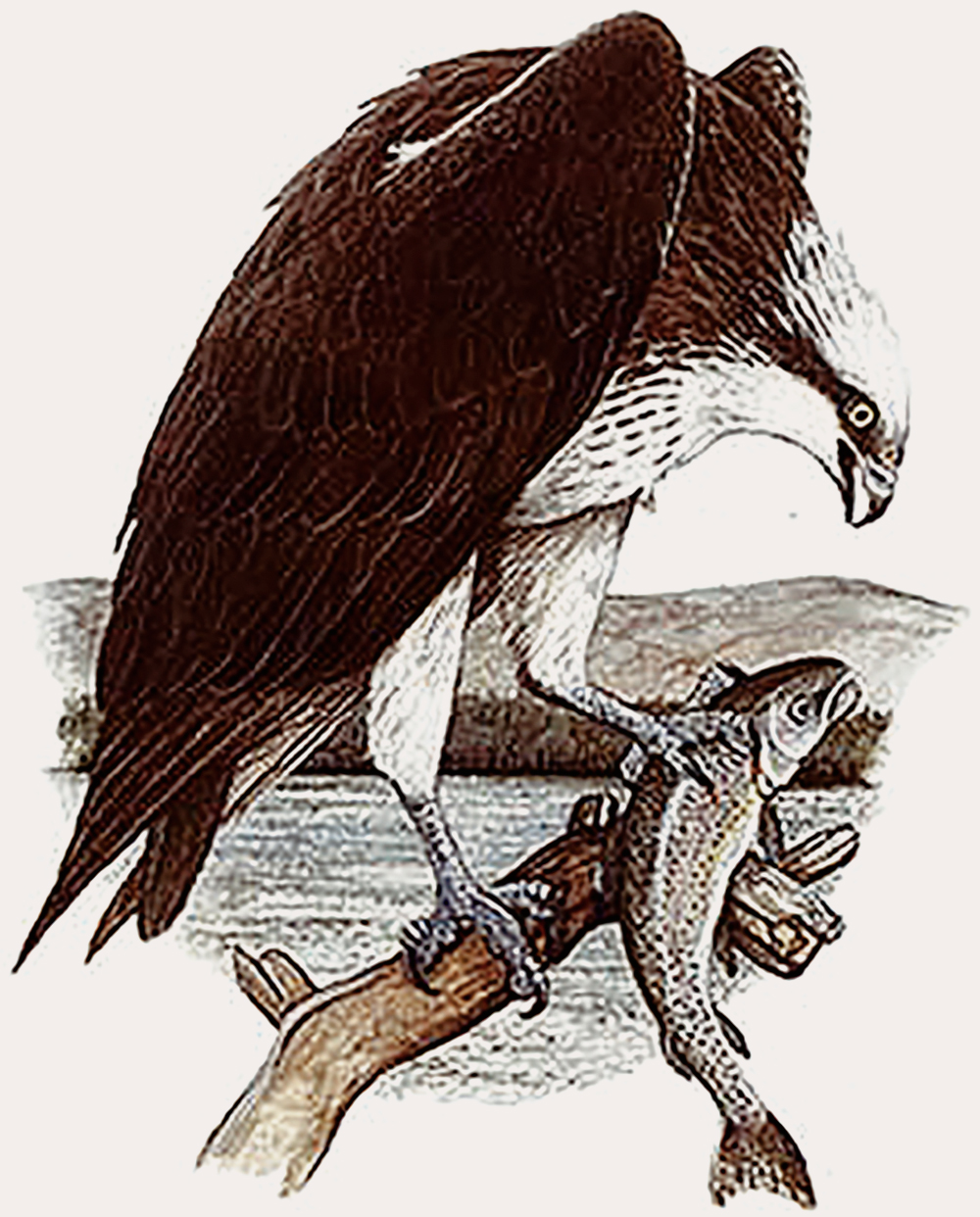
The same thing happened on the island of Malta, home of the oldest buildings in Europe. The Temples of Malta, which pre-date the Pyramids, are mainly above ground and built on a basic plan that resembles the outline of a Fertility Goddess. Two underground Temples have been discovered. They are mined out of the native limestone and follow the same design. Discovered within these underground temples were thousands of long bones and skulls, the men in one section and the women in another.
When the West Kennet burial chamber near Stonehenge was opened again long bones and skulls were found. The same thing occurred in Ireland. I wonder if this was a universal practice that has been in existence for tens of thousands of years. It seems very unlikely to me that the meme of revering long bones and skulls started in Australia and moved to Europe?
In the Himalayas only a few years ago a friend of mine witnessed the practice of a ritual dissection of a corpse, before exposure so the vultures could devour it.
What was the purpose of the Dabous Giraffe carvings in Niger? Obviously the site was sacred and must have been visited by many people over a great number of years. Jean Clottes and his team recorded 828 smaller carvings surrounding the Giraffe carvings. Near the site are several tumuli and I wonder what is hidden within them? Could it be human skulls and long bones? When I slept beside the Giraffe carvings in 1999 I had the worst nightmares I have ever experienced. People were being killed left right and centre and blood was flowed everywhere. If my dreams were any indication of the Spirit of the Place, the purpose of the Dabous Rocks was very much attached to death. Could it have been used for the exposure of the dead?
In the dead volcanic crater of Arakua, east of the Air Mountains and on the edge of the Sahara Desert, is a vast tumulus. It covers the area of two tennis courts and is over six feet high. What is it for? Could it be hiding the skulls and long bones of people that died when the Tenere was the home of thousands of Hunter Gathers? The only purpose I can think of is that the tumuli was slowly built up over a great many years as the skulls and bones of the dead were buried around it. Thousands of man-hours must have gone into building this giant stone heap.
The Egyptians took the process the next step by believing that the mummified body would be rejuvenated in the After Life. This practice was dropped as soon as the meme caught on that we didn’t need bodies in the Next Life. One of the reasons we respect the memory of the dead could possibly be that the living don’t want their spirits to come back and haunt them.
So what did the Bear Clan do with their dead? Did they also collect the skulls and long bones? I can’t help but think that such a sophisticated people must have done something similar to their dead as the Unambal. Because the Clan would have passed Chauvet only twice a year, once in the early Spring and again in the late Autumn, as they hunted the migrating herds that passed along the Ardeche Canyon, I doubt if an ossuary will be found near the Arch. Another possibility is that the Chauvet people could have dealt with the problem of bodies in the same way as the Eskimos of northern Canada did. In the past the dead and dying were taken out and left for the Polar Bears to deal with. Did the Bear Clan use the Lions in the same way? It would have been a very tidy way of solving the problem, and the one thing these people were was very practical. Such a solution was not available to the Unambal or the Orkney people.
I believe that Religion evolved in three separate but linked Steps. The first step is taken when a group bonds together and develops a Set of Rules for their mutual protection. Mankind’s Rules evolved into a Code of Conduct. The next step was the enforcement of the Code of Conduct on the group by a mutually respected Elder. He was able to do this by imposing a pattern of ritual behaviour on the group through Taboos backed up by ceremonies of song and dance. Such a man was probably a respected Healer and became known as the Medicine Man or Shaman. His power came from claiming that he could communicate with a supernatural force that he could use to punish an offender or to ensure a successful kill. The third step is reached when the whole group believes they can communicate with the Supernatural Force who they can appeal to for help in their present life and join in the After Life.
For me the discovery of the Art in the Chauvet Cave is as important as Mankind walking on the surface of the Moon. I believe that Art is the pinnacle of Human Civilisation. Sperone Speroni, a Renaissance writer living in Florence in the 16th century, defined the key to Civilisation as “the Creation of Wealth and the Patronage of the Arts”. Art is the culmination of Mankind’s achievements and its existence in the Chauvet Cave is breathtaking.
I wouldn’t mind betting that the hunters of the Bear Clan acted as patrons to their artists. I can just hear them saying, “You stay in the cave and paint and I will go get some meat for you to eat”. If they thought that the Animal Spirits protected the herds and could help them make a kill, they would surely make certain that their artists were properly looked after.
When Jean joined my wife and myself for dinner in the local restaurant of Vallon Pont d’Arc, we took the opportunity of giving him a “thank you” present for asking me to join his team. When visiting my studio he had admired a small bronze I had done many years before based on an Alexander Pushkin poem about a young girl releasing a swallow outside the church door after the Easter service. When I look at the sculpture it makes me think of the Chauvet Spirit World.
Thinking about the Bear Clan and Chauvet has been like a trip over Niagara Falls in a barrel. If the earth was to open up and the Chauvet Cave was to disappear forever, I can not think of a greater loss to mankind. There is simply nothing else like it in the world, including my beloved Nefertari Tomb or the Sistine Chapel. Nothing compares to Chauvet, as the art is the first evidence of a Civilisation that existed during the last Ice Age.
I compare Chauvet to the Renaissance. For me it was an awakening, a gathering together of all the knowledge that I have collected during my life. Chauvet literally shook my Mind.
What we call Civilisation is part of Evolution and therefore subject to Darwin's conviction that there is "No innate tendency to progressive development". Mankind constantly has to adapt to the environment. We have to accept that Civilisation is merely a by-product of the giant Universal mechanism of Evolution and that there is also an "innate tendency to inevitable destruction".
Consider the ancient urban Civilisations starting with the 8,000-year-old urban development of Catal Huyuk in Asia Minor. Catal was followed by Babylon, Malta, Stonehenge, Egyptian, Minoan, Greek, Roman, and so on. They are all stepping stone in the evolutionary fight for survival of Civilisation. One by one they collapsed and were replaced. They proved to be unsustainable. Undoubtedly our present Civilisation will also collapse and be replaced because it also is unsustainable.
Social success lead to peaks in Civilisation, but some form of catastrophe always causes these peaks to collapse, be it ice, floods, super volcanic eruptions, famines, disease, or plagues. Success also seems to bring about a lack of resolution and a dilution of the survival instinct in Mankind. It invariable leads to over population, a diminishing of resources, dependency on cheap labour. Perhaps success causes a weakness of resolve that leads to collapse.
Without doubt Hunter-gather societies lead the most sustainable existence possible. For 60,000 years the Australian Aborigines lead such an existence before it was ended by the arrival of Europeans 250 years ago.
The Chauvet Cave was only used for religious ceremonies, on and off, for over a period of 5,000 years, a greater length of time than between now and the building of the Pyramids. The Bear Clan were part of a very successful society as shown by the quality of their art. I suspect that even if the Ice Age had not happened their society would have eventually collapsed. They were too inventive, too intuitive, too creative, and too artistic. They were "forward thinkers" and so probably doomed by their own ability.
The Australian Aborigines lived in a static state, surviving off the land by following a set of rules that never allowed their population to reach beyond the food supply. It was a remarkable achievement and lasted sixty thousand years. If a series of good years raised the population, droughts quickly reduced it again because the women stopped having babies.
Of course every life is precious to the individual family, but it is not precious to the overall Society, especially if the added burden is seen to be a danger to the whole. Mankind needs to think about "Earth's carrying capacity", something I am sure the Chauvet Bear Clan knew all to well.
One of the Greek philosophers said, "Mankind is made up of three parts, his Body, his Life and his Mind. The only one we have any control over is our Mind. All the rest is mere smoke". It's true.
The only justification I can think of for being allowed into Chauvet, is to share with you, the viewers, just a little of the miracle of the Chauvet Cave. In my humble opinion it is The Wonder of the World.
→ Rock Art on UNESCO’s World Heritage List
→ Colloquium - France/Spain October 2019
→ L'Atlas de la grotte Chauvet-Pont d'Arc
→ The Final Passage
→ The Final Passage - FAQ
→ France Rock Art & Cave Paintings Archive
→ Chauvet Cave
→ Lascaux Cave
→ Niaux Cave
→ Cosquer Cave
→ Rouffignac Cave - Cave of the Hundred Mammoths
→ Bison of Tuc D'Audoubert
→ Geometric Signs & Symbols in Rock Art
→ The Paleolithic Cave Art of France
→ Dr Jean Clottes
→ Bradshaw Foundation
→ Rock Art Network
